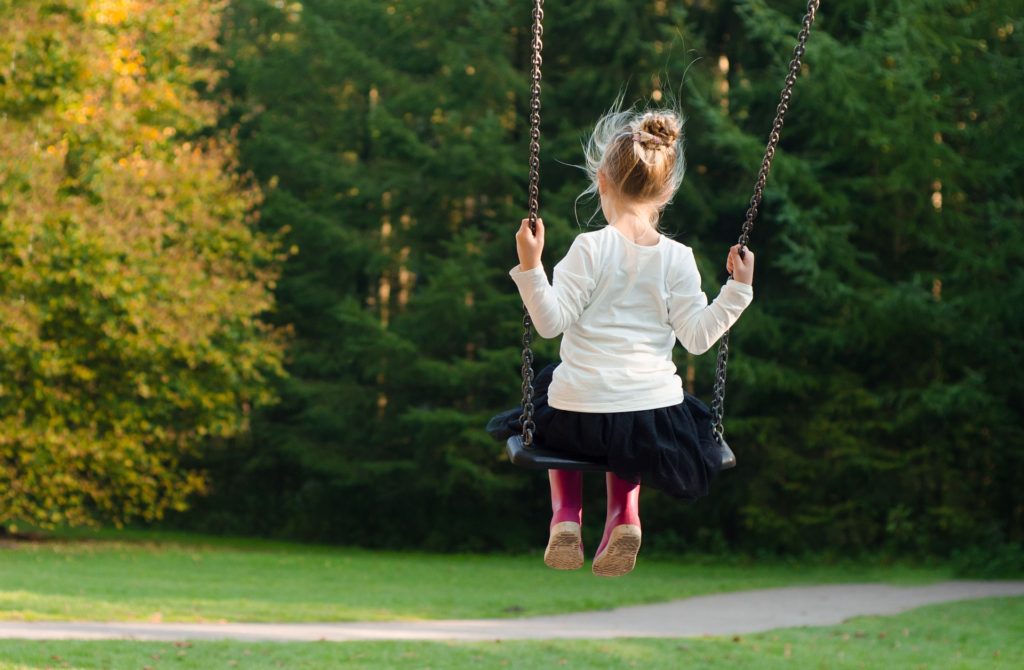The other day I was at the playground with my daughter and her friend. I was talking to her friend’s mom and we were looking at our girls play together, surrounded by a lot of other kids and parents. Our conversation hit a serious subject. The “when is it time to talk about it” subject. The world is a scary place and you want – you need – to protect your children from the dangers it holds. But you also want them to be “just kids” for as long as possible. You don’t want to “corrupt” their innocence by lifting the curtain that cloaks those dangers. Yet you also need them to be prepared, smart, resilient and able to protect themselves to a certain degree. So, when is it time to talk about it?
The Puppy Conversation
There is this video in which parents are asked if they think their kid will follow a stranger to his car, if that person has a cute puppy and promises the child there are many more cute puppy’s in the back of his car. The parents say “no way, my kid knows not to go with strangers“.
Spoiler alert: all the kids follow the stranger to his car.
My friend and I discussed this video and we agreed, in all honesty, that we were pretty sure our daughters would do the same. Our kids are trusting and caring and they love puppy’s. Basically, all features every healthy three year old should have. To be clear, my three year old never plays outside by herself. She is never more than a few meters away from me and I watch her like a hawk on steroids. Also, my kid is quite obedient: she never “runs off”.
But still.
What if it happens in a store or a busy street. Three year olds are fast. She runs around a corner, I loose track of her for a minute and… enter “the kind stranger with the puppy”. There are a thousand ways in which a watchful parent and an obedient child can get into trouble. Trust me, I’ve thought about most of them.
So, maybe it is time to have The Puppy Conversation.
The No Touching Conversation
My daughter went to daycare for about a year and now she is in preschool. We selected both the daycare and the school with great care and talked to the staff before she entered. Everything checked out and everyone seemed nice and caring and, you know, quite sane.
But every time you hear about sexual abuse concerning children at school or during sports, the parents that have kids at the affected school or daycare are in complete shock. Of course they didn’t suspect “that” person. [If they did, they wouldn’t have let their kids go there, duh!] Abuse is almost always hidden. And abusers are masters at keeping their acts and desires hidden. And they know how to make sure their victims don’t break that secrecy.
The statistics of sexual abuse are horrifying. One in ten children will be sexually abused before the age of eighteen. 20% of them are abused before they turn eight. 90% of child sexual abuse victims know their abuser.
So yes, it is time to have The No Touching Conversation.
But how?
How do we talk about these horrible things, with our preschoolers? We want them to stay trusting, carefree souls, while simultaneously have access to active knowledge about these dangers. We want them to listen to and respect grownups and also know when and how to say “no”. We want them to dive into life, with an open heart, but at the same time be safe. We need them to hear us, but we don’t want to scare them (too much) and give them nightmares.
That brings me to an important aspect of these talks: will they get it? Will they not only hear us, but also understand us?
How do you make a three or four year old understand an abstract event, in a variable time and setting? How will they be able to apply what you tell them to a certain situation?
Talk Tips for The Puppy Conversation
- What is a stranger? A stranger is an abstract concept for a small child. A stranger can become your best friend in 30 seconds if you are a three year old. You need to explain the concept and give many (many!) examples.
- Talk about it in different settings. Your child is more likely to apply what you said about “strangers at the playground”, if you talk about it at home and then at the playground. Also, small children are not able to make the mental translation from playground to, let’s say, the Ikea yet. So you need to repeat your talk in different situations and settings you consider a risk. They will start to recognize a situation eventually.
- Create mental images of differents situations. Don’t just say “you are not allowed to go with strangers”. You need to explain they can’t take food from strangers, they can’t say yes if a stranger asks for help “around the corner” or if the strangers tells them “your mommy asked me to come get you”. If you have a hard time imagining potential threats, google examples. For instance, everyone can buy a uniform that looks real and impressive to a child, so you can’t teach your child to trust everyone in a uniform: they still need to ask mommy, if they are asked to come with them.
- Three Simple Rules. Have a short, simple set of rules ready, that your child can remember at all times. For instance: always ask mommy/daddy first, before you go somewhere. Don’t take food from other people (and kids). Don’t go with strangers.
- The Rescue Plan. Make sure your child knows what to do in a risky situation. If he’s playing outside, what neighbors he can go to. If he gets lost in the supermarket or at the beach, who to talk to.
- Repeat. And then repeat again. You know how you need to ask you children to put their shoes away about three-thousand times before it becomes a habit? Those are just shoes. Imagine how difficult it is for them to grasp something as complicated as The Puppy Conversation? Repeat the talk and keep talking about it.
- Don’t go in obsessive mode. Yes, you need to repeat it and keep talking about it. But don’t turn the talks into a stressful event. If you go into OCP (obsessive-concerned-parent) mode, your child will more likely become afraid of playing outside or get nightmares.

Kiko and the Underwear Rule
Sexual abuse is possibly an even more difficult and sensitive subject to talk about with your child. You can’t just go “so remember, don’t let the teacher touch you!” every time you drop your kid off at preschool. It’s a completely different talk than the don’t-go-with-strangers talk.
It is something you do at home, in a safe and calm environment. And you make it simple. As simple and matter-of-factly as you possibly can.
- Together you talk about your kids body and all the different parts
- You specify the areas that nobody is aloud to touch
- “Nobody” means both strangers and people (and kids) they know (!)
- Together you repeat those ares
- You learn them what to say and do if someone does touch them in these areas
- You make sure they have that same safe and calm place to come to if something happens
- You make sure you know where to turn to for help for your child
- You make sure you know where to turn to for help for you
Books are a big help when it comes to difficult parenting subjects. You can read them multiple times, without turning the subject into a Big & Stressful Event. For instance, to help prevent sexual abuse there is an international campaign concerning “The Underwear Rule”. Books, video’s and posters help kids in the ages 3-7 understand it is not okay if people touch them in certain places. Needless to say, this is not just a conversation you need to have with your daughter. Boys are also victims of sexual abuse.
For the English version: Kiko and the Hand
For the Dutch version: Kiko en de Hand
For more languages, click here.
More Dutch books:
“Nee” van Sanderijn van der Doef
“De Baas over je lijf” van Melanie Meijer
Get all the info and help you need
If you feel like you need more help talking to your child, go online and do research, or talk to your GP or someone at the child care/ child health centre. If you are a victim of sexual abuse yourself, it could be wise to have some help or get advice when you have these talks with your child. Talking about it in a context that concerns your child could trigger trauma and put stress on you and your child. Know you are not alone and don’t have to do it all by yourself.


